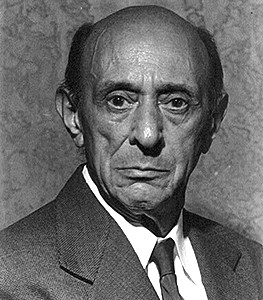Arnold Schönberg:
The Father of Negative Music
By Don Robertson (1997)
Arnold Schönberg (1874-1951) (also spelled Schoenberg) was the Jewish composer who opened the door to negativity in European classical music at the beginning of the 20th century. This Viennese composer began composing when he was eight. In his late teens, he took Alexander von Zemlinsky, an Austrian composer of the time, as his teacher. At the turn of the century, he wrote an impassioned string sextet called Verklärte Nacht that showed strong influences of Brahms, Wagner, and Hugo Wolf. Between 1901 and 1903, Schönberg wrote a large oratorio called Gurrelieder and completed the orchestration (for a massive orchestra) ten years later. In this brilliant work, Schönberg achieved a pinnacle in romantic composition. The work, for large orchestra, is largely influenced by the symphonic works of his contemporaries Gustav Mahler (1860-1911), and Richard Strauss (1864-1949). Both of these composers were at this time opening the doors in music to the expanded use of dissonance and creating music that was more anguished and emotionally expressive of negative feelings–such as frustration and anguish–than had been created before.

Mahler’s Fifth, Sixth and Seventh Symphonies were all composed between 1902 and 1905 and Strauss’ Opera Solome, an emotionally intense work that strained the limits of traditional music tonality almost to the breaking point, as it dealt with the underside of human psychology, was a product of the year 1905. These were transitional works between the spiritual plateaus of the Wagner music dramas and the first works of determinedly negative music composed by Schönberg and his contemporaries. However, Gurreleider, primarily composed between 1900 and 1903, was a work that contains an impassioned emotional statement, filled with music of rare beauty. It was the last of Schönberg’s tonal Mohicans.
Also in 1903, Schönberg began taking on private pupils. Among the first were Alban Berg (1885-1935) and Anton von Webern (1883-1945). They would become important composers in the realm of the new negative music. At this time, Schönberg began moving rapidly forwards with his musical style. In 1905, he completed his first published string quartet. This work showed a dramatic departure from the full, inspired feelings of Gurreleider. It is a complex work of a shadowy emotionality character. The inspired emotional peaks that ‘feel good’ in Gurreleider, are in this work, gone. Schönberg had entered a wilderness. In the Chamber Symphony of 1907, Schönberg stretched the limits of traditional harmony to its limits.
It was during the next two years that Schönberg made his biggest transition. I will describe the music and influence of this period with a quote from Twentieth-Century Music by Robert P. Morgan (published by W.W. Norton & Company in 1991):
“With the Chamber Symphony we have reached the absolute limits of traditional chromatic tonality. The period immediately following its appearance was critical in Schönberg’s development—and indeed, largely because of the direction he took, one of the most important in the entire evolution of Western Music. In a two-year period of astonishing creative activity, from 1907 to 1909, Schönberg made his final break with tonality and triadic harmony and moved into the previously uncharted area of free chromaticism, producing a series of works that fundamentally altered the course of music: “The Second String Quartet, Opus 10”, “Three Piano Pieces, Opus 11”, “Two Songs, Opus 14”, the song cycle Das Buch der hangenden Garten (The Book of the Hanging Gardens) Opus 15, “Five Orchestral Pieces, Opus 16” and the drama Erwartung (Expectation) Opus 17. In one sense Schönberg’s break with tonality can be understood simply as the next step in a continuous development, for in his music the role of triads and key centers had already been weakened to a point of virtual extinction. But this step was decisive, producing a difference in kind rather than merely of degree. As Schönberg himself proclaimed in the program for the first performance of his Opus 15 songs: “For the first time I have succeeded in coming near an ideal of expression and form which I had in mind for years…..Now that I have finally embarked on the path I am conscious that I have broken all barriers of a past esthetic.”
Never before had music been composed that abandoned the precepts of tonal harmony that had been employed throughout time, in all civilizations: the very laws of nature that allow music to express harmonious and positive emotions.
With these compositions, Schönberg began to compose music that was not completely based on the harmonic laws of music: natural, vibratory frequencies of nature, and instead this music entered into emotionally dark regions that no music dared to venture before. The last three compositions from this period (Opus 11, No. 3; Opus 16, No. 5, and Erwartung) were completely freed from reliance on natural harmonic principals and melodic expression. When these works were played in public, audiences were bewildered, shocked, and angry.
During this period, Schönberg was in communication with the painter Wassily Kandinsky, an early figure in twentieth-century art. Schönberg’s entrance into the world of discordant music took place at the same time that Kandinsky’s first abstract paintings – negative art – were painted.
Like Schönberg, Webern and Berg’s early compositions were tonal compositions in the style of earlier composers, but each of these composers made the break away from tonality. Webern’s Opus 2, composed in 1908, composed for a cappella choir is freely discordant and is emotionally dark and even frightening. Opus 3 and 4 consisted of short songs for voice and piano. These are darkly expressive. With his Five Pieces for String Quartet, Opus 5, Webern’s style began to develop. The Six Pieces for Orchestra, Opus 6, composed in 1909, contain a kind of music unheard of before, completely revolutionary for its time. This is the music that will fill the homes and motion picture theatres of America during the last half of the twentieth century. It is music of terror, suspense, and fear. In it we hear the coming world of great industrial machines, concrete, and steel. Soon, Alban Berg followed his teacher and fellow student into the world of negative music also.
This trio of composers, dubbed “The Second Vienese School” to give them the status of Mozart, Schubert and Beethoven, thus opened the doors to the darkness of the 20th century. At first, the concert-going public will lash out at it, but slowly, the discords will hypnotise them, or at least John Q. Public will only grumble about it, and then move on.
